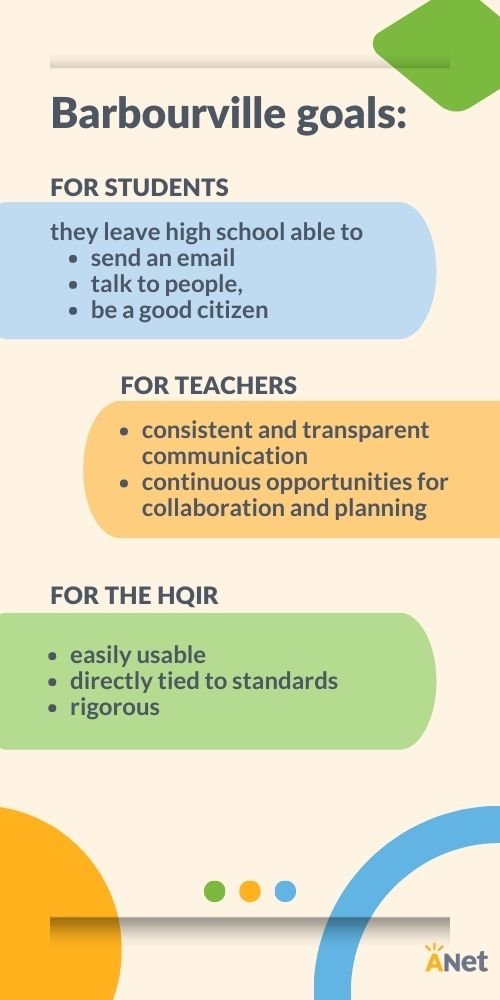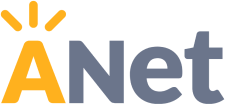BACKGROUND:
The Kentucky Department of Education (KDE) selected Achievement Network (ANet) as their trusted partner to support their districts with a pilot program for selecting and implementing high-quality instructional resources (HQIR). In January 2022, ANet coaches and KDE staff created and administered five professional learning sessions describing the why, how, and what of high-quality instructional resources and ANet coaches began coaching participating districts in between professional learning sessions to develop their strategy for HQIR.
When Barbourville ISD decided to apply to the pilot program, their district leaders knew the program would help their staff gain a unified purpose with their ELA resources. Barbourville administrators felt the program could help staff to meet students’ needs after COVID-related learning loss and be ahead of any future statewide HQIR changes. Barbourville staff worked with ANet Coach Ramone Carson through the Kentucky Department of Education’s Curriculum Development Process to first address their middle and high school curriculum.

Preparation - Every person, every resource, every minute in service of students
As soon as the reading and writing pilot got underway, Barbourville administrators knew from the professional learning series that to be successful they needed to approach the process with a unified plan from all stakeholders. Their district leaders were new to their positions but long-time district employees, eager to create coherence between the district’s mission, vision and strategic plan to ensure what’s best for Barbourville students. Closely after a decision was made to apply for the pilot program, leadership convened ELA teachers across the district to gather input and start a planning process.
“The biggest part of it from my end as the Chief Academic Officer was to ensure we had teacher buy-in immediately. There is nobody more important using the resources, finding the resources, taking those and making it their own personalized resource, than the teachers…if the teachers aren’t involved you’re not going to be successful,” said Chief Academic Officer Joshua De Borde.
Part of their conversations involved honest discussions between the ELA teachers and administrators over what was working, what wasn’t working, and where they see major gaps for their students, especially those recovering from COVID-related learning disruptions. This left them with a list of resources and parts of the curriculum that they all felt confident in. The teacher-leader group used that information to put together a priority list of what they wanted and needed to fill the gaps, and set up criteria to evaluate the resources with student data, teacher needs, and Kentucky Department of Education samples and resources. Their goal was to ensure every person in the Barbourville district would have 100% confidence that every resource selected could serve every student.
“They [teachers] feel like they have had more voice in this than they've had in a long time as well,” said Barbourville instructional coach Andrea Hillard.
Thanks to their work synthesizing student and teacher needs, ANet coach Ramone Carson worked with De Borde and the team to create criteria for selecting resources and used tools such as EdReports to aid in the selection process. The team took these self-created criteria and tools and collaborated with colleagues across the state and KDE to choose Study Sync ELA. As the curriculum team moved through the vetting process, Carson was a key thought partner helping to keep the focus on overall outcomes and providing a sounding board for Barbourville educators.
Professional Learning - Individualized professional learning, mentorship, and communication
An important component of the pilot program is a professional learning plan to support teachers with using the HQIR. De Borde’s goal was to individualize every single teacher’s professional development. District administrators sought to ensure teachers felt confident in their developing ELA philosophy, knowledgeable of their new resources, and able to form connections between standards and resources for their students. Their professional learning vision involved:
-
an increase in planning and PLC time,
-
opportunities for teachers to talk to each other about what they need from each other one-on-one and in groups,
-
providing formal and informal feedback, and
-
creating a pathway for mentorship for teachers with different experiences.
“Mr. De Borde walked us through, you know, what they were expecting out of us this year…I had the opportunity to ask questions and to see what exactly we were doing,” said ELA teacher Michaela Miller.
Professional learning also played a role in the criteria for curriculum vendors. De Borde asked each company they vetted about professional learning of their platforms and resources available as a criterion to vet vendors. Trainers at Study Sync ELA created training every step of the way with one-on-one support and group professional development to make sure educators felt confident at the start of the school year with the program.
“I felt like most of the things we did have questions about they were always readily available to answer them…The presenter was fantastic, knowledgeable, and we did get a lot of hands-on time,” said high school ELA teacher Brandon Simpson.
The hands-on and knowledgeable professional learning of both the process of evaluating and implementing HQIR, and the work to get teachers comfortable inside the Study Sync platform, helped educators feel confident using the platform and instructional resources and knowledgeable of ways they could still individualize and personalize instruction to serve their students’ needs.
.jpg)
Developing the Curriculum - Collaboration toward what our students need to be able to do when they graduate
Barbourville’s team put together a living document that spelled out the vertical progression of each literacy standard and detailed how teachers from every grade level can ensure mastery of the standards. Teachers from each grade level collaborated around what they want their students to be able to do when they entered their classroom and when they left, consulting between grade levels to ensure there was alignment.
“I've been here 19 years, and I don't know if I've ever got to communicate with the elementary teachers as much as I have during this process,” said Simpson.
Parents, guardians, and community members provided feedback on the Barbourville HQIR philosophy and plan and shared thoughts on what was most important for their students to be able to know and do. The positive feedback from the district’s external stakeholders provided validation and direction for their curriculum and resource selection.
“I just can't emphasize enough what a positive experience it was for us, and not just positive but very useful. Usually, you listen to something and a lot of time forget about them, but this was very actionable and useful. And we put it to use,” said instructional coach Andrea Hillard.
Implement and Monitor - Defining success
The administrative team utilized their partnership with ANet to establish quarterly improvement plans as they implemented and monitored the HQIRs. ANet Coach Ramone Carson trained De Borde and the middle and high school administrators in a change management framework that helped the administrators be specific in the feedback they gathered, notice the outcomes they hoped to achieve, and be able to adapt to best support teachers and students. In the first quarter, Carson assisted the administrators in developing their quarterly improvement plans (QIPs) and provided feedback to the administrators on their plans after visiting the campus and hearing reflections. During the second quarter, Carson helped De Borde support his administrators to facilitate the feedback process with teachers and view early evidence of progress. Carson also supported the team of administrators to create systems to gather teacher and student input.

Administrators were clear through developing their QIPs about what they wanted to know from those involved in the ELA HQIR process. Their goals and consistent communication informed the administrative observation process to set clear, informed, and transparent goals so that when administrators visited the classrooms, teachers knew what they were looking for and what to expect. Teachers and administrators established regular touchpoints and communication channels.
“One of the biggest differences I've seen is [with] the teachers since they felt like it was something that they created. I feel like they take more pride to make sure we see it,” said Barbourville instructional coach Andrea Hillard.
In addition, Carson helped the ELA team develop the infrastructure to get bi-monthly student feedback from different grade levels. They meet with students in person and ask them to compare their classroom experiences before and after implementation; this enables them to gain valuable feedback while strengthening their relationships with students. Additionally, the Barbourville team deployed a student climate survey to gather quantitative feedback. Teachers and leaders use the quantitative and qualitative student data as a check to make sure students feel ownership and clarity over what they’re learning and allow teachers and administrators to make ongoing adjustments to meet students where they are at. The district leadership team will review student responses as they continue to adapt the HQIR curriculum and plan HQIR changes in other subjects.
“I’ve seen an improvement from my students not only in length [of writing] but also in analyzing the text, providing evidence, and utilizing secondary resources,” said ELA teacher Michaela Miller.
CONCLUSION
Barbourville staff progresses through their current ELA HQIR implementation and expands their ELA curriculum coherence at the elementary level. District leaders and teachers work together with Carson to gather data and plan to adapt based on their students' needs. The district continues to learn as they develop a plan for analysis and implementation of other subjects, such as math, science and social studies, thanks to their learnings from this pilot program.
ABOUT ANET SYSTEM PARTNERSHIP WITH KENTUCKY DEPARTMENT OF EDUCATION
The Kentucky Department of Education selected the Achievement Network to conduct the implementation of high-quality instructional resources in ELA, math, and now science through a pilot program for school districts in Kentucky. Each pilot district will experience a professional learning series alongside job-embedded coaching to vet resources and set districtwide vision and goals for the preparation and development stages and then continues to work with their coach throughout the implementation process to assess progress.

